Une extension spécifique à un site vous permet d’ajouter facilement des extraits de code à votre site WordPress sans dépendre de votre thème. Il vous permet d’utiliser un code personnalisé pour améliorer votre site et de ne pas vous soucier de devoir tout refaire lorsque votre thème est mis à jour.
Chez WPBeginner, nous avons créé beaucoup d’extensions spécifiques au site pour ajouter des shortcodes, de nouveaux types de publications et d’autres fonctionnalités à notre site dans le passé. De plus, nous avons également aidé nos clients à démarrer avec des extensions spécifiques à leur site.
Dans cet article, nous allons vous expliquer comment créer une extension WordPress spécifique à un site et pourquoi c’est important.
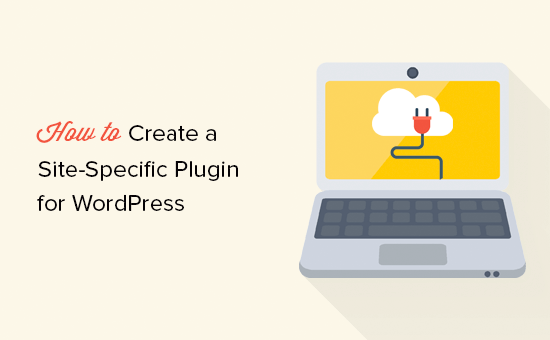
Qu’est-ce qu’une extension WordPress spécifique à un site ?
Un plugin WordPress spécifique à un site est une extension autonome que vous pouvez utiliser pour ajouter tous les extraits de personnalisation qui ne dépendent pas du thème.
Lorsque vous travaillez sur votre site, vous trouverez souvent des tutoriels WordPress vous demandant d’ajouter du code au fichier functions.php de votre thème ou à une extension spécifique à votre site.
WordPress n’est pas livré avec une extension spécifique au site. Vous devrez créer le vôtre, puis l’installer et l’activer.
Pourquoi créer une extension WordPress spécifique à un site ?
Comme nous l’avons mentionné précédemment, vous trouverez souvent des tutoriels montrant un code que vous pouvez ajouter au fichier functions.php de votre thème ou à une extension spécifique à votre site.
Ces codes personnalisés peuvent être utilisés pour ajouter de nouveaux types de publications, des taxonomies, des shortcodes et des tonnes de hacks pour améliorer votre site.
Si vous ajoutez le code personnalisé au fichier de fonctions de votre thème, il disparaîtra si vous mettez à jour ou changez de thème.
Vous pouvez créer un thème enfant et utiliser le fichier de fonctions du thème enfant pour enregistrer votre code. Cependant, votre code disparaîtra toujours si vous changez de thème.
Un plugin WordPress spécifique à un site vous autorise à ajouter facilement des extraits de code personnalisés à votre site WordPress et à vous assurer qu’ils sont indépendants du thème. Il s’agit d’une extension WordPress autonome, ce qui signifie qu’elle ne dépend pas de votre thème et que vous êtes libre de mettre à jour ou de changer de thème.
Cela étant dit, voyons comment ajouter facilement du code personnalisé à l’aide d’une extension spécifique au site. Nous allons vous afficher deux façons de le faire, et vous pouvez choisir la méthode qui fonctionne le mieux pour vous (Conseil : la méthode #2 est plus facile pour les débutants).
Méthode 1 : Créer manuellement une extension WordPress spécifique au site
Nous savons que cela peut sembler un peu compliqué pour les débutants, mais nous allons essayer de rendre les choses aussi simples que possible pour vous.
Tout d’abord, vous devez créer un nouveau dossier sur votre bureau et lui donner le nom de votre site. Par exemple : mywebsite-plugin.
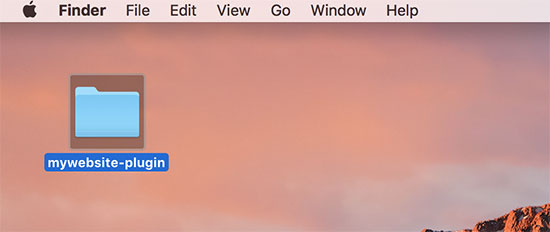
Ouvrez un éditeur de texte sur votre ordinateur, comme Notepad ou TextEdit.
Vous devez créer un nouveau fichier et l’enregistrer sous mywebsite-plugin.php dans le dossier de l’extension sur votre ordinateur.
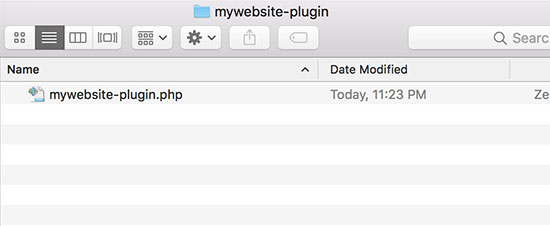
Votre fichier d’extension a besoin d’un code d’en-tête spécifique pour que WordPress puisse le reconnaître en tant qu’extension. Allez-y et ajoutez le code suivant à votre fichier mywebsite-plugin.php :
1 2 3 4 5 6 7 8 9 | <?php/*Plugin Name: Site Plugin for example.comDescription: Site specific code changes for example.com*//* Start Adding Functions Below this Line *//* Stop Adding Functions Below this Line */?> |
Vous pouvez remplacer exemple.com par votre propre nom de domaine. Une fois que vous avez fait cela, votre extension spécifique au site est prête.
Il existe deux façons de téléverser votre extension spécifique à votre site. Vous pouvez soit le téléverser via votre panneau d’administration WordPress, soit utiliser le protocole FTP.
1. Installer l’extension spécifique au site depuis la zone d’administration de WordPress (recommandé)
Cette méthode est plus simple et recommandée pour toutes les utilisatrices/utilisateurs.
Tout d’abord, vous devez créer un fichier zip du dossier de votre extension spécifique au site.
Les utilisateurs/utilisatrices de Windows peuvent simplement cliquer avec le bouton droit de la souris sur le dossier de l’extension et sélectionner Send to ” Compressed (zip) folder.
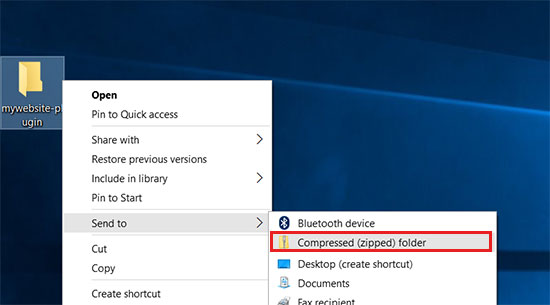
Les utilisateurs/utilisatrices Mac doivent cliquer avec le bouton droit de la souris.
Sélectionnez ensuite “Compresser mywebsite-plugin”.
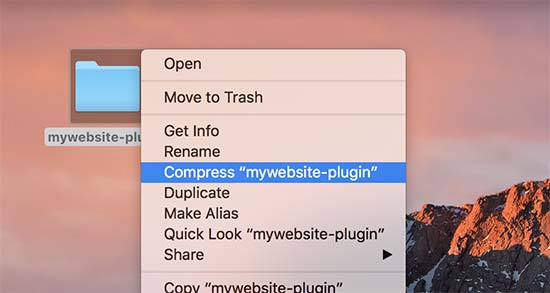
Une fois que vous avez le fichier zip de l’extension, allez sur la page ” Plugins ” Ajouter une nouvelle dans votre zone d’administration WordPress.
Cliquez ensuite sur le bouton “Téléverser l’extension” en haut de la page.
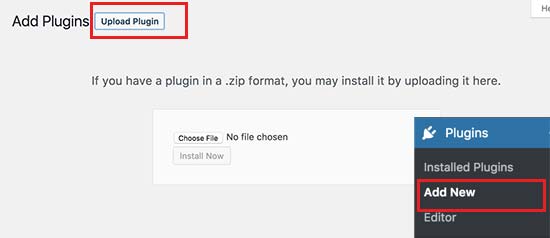
Ensuite, cliquez sur le bouton “Choisissez un fichier” pour sélectionner le fichier zip que vous avez créé plus tôt, puis cliquez sur le bouton “Installer maintenant”.
WordPress va maintenant téléverser et installer l’extension pour vous. Une fois téléversé, vous devez cliquer sur le bouton “Activer le plugin” pour commencer à utiliser l’extension spécifique à votre site.
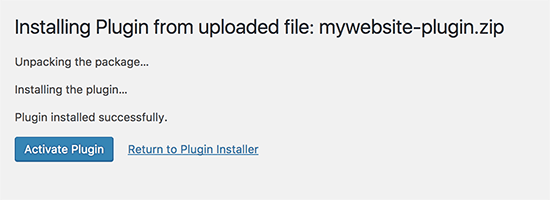
2. Téléverser le plugin WordPress spécifique à votre site via FTP
Pour cette méthode, vous n’avez pas besoin de créer un fichier zip. Vous téléverserez l’extension via FTP.
Tout d’abord, vous devrez vous connecter à votre site à l’aide d’un client FTP.
Une fois connecté, rendez-vous dans le dossier /wp-content/plugins/ dans la colonne du site distant. Sélectionné, vous devez sélectionner le dossier de votre extension spécifique au site et le téléverser sur votre site.
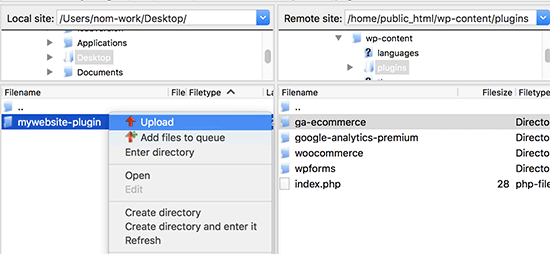
Votre client FTP va maintenant transférer le dossier de l’extension spécifique à votre site sur votre site WordPress. L’extension sera ainsi installée sur votre site.
Cependant, vous devrez toujours activer l’extension pour commencer à l’utiliser. Vous pouvez le faire en allant sur la page “Plugins” dans votre zone d’administration WordPress et en cliquant sur le lien “Activer” sous le plugin spécifique à votre site.
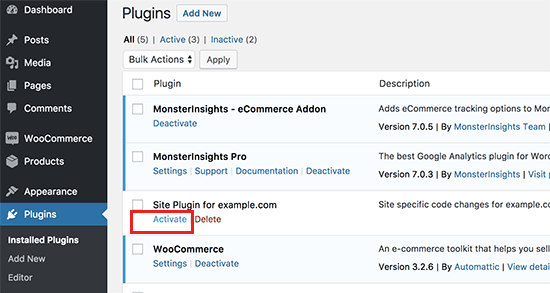
C’est tout. Votre extension spécifique au site est maintenant prête à être utilisée.
Ajout d’extraits de code personnalisés à votre extension spécifique au site
Il existe deux façons de modifier votre extension et d’y ajouter des extraits de code personnalisés.
La première méthode consiste à le faire via la zone d’administration de WordPress. Vous pouvez vous rendre sur la page ” Éditeurs/éditrices ” des extensions.
Un message d’avertissement s’affiche et vous devez cliquer sur le bouton “Je comprends” pour continuer. Si vous souhaitez modifier les fichiers de manière plus sûre, passez à la deuxième méthode ci-dessous.
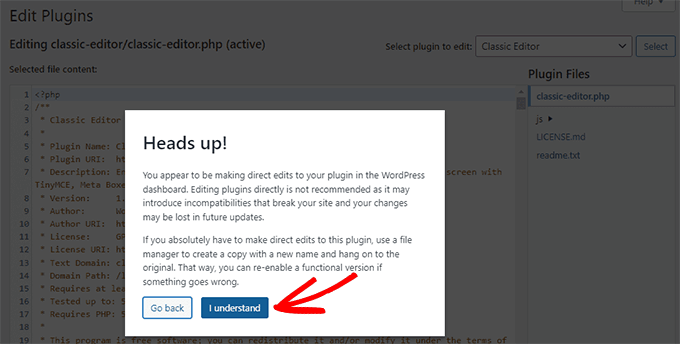
Ensuite, vous devez sélectionner l’extension spécifique à votre site dans le menu déroulant libellé “Sélectionner l’extension à modifier”.
L’éditeur chargera votre fichier d’extension et vous pourrez y ajouter des extraits de code.
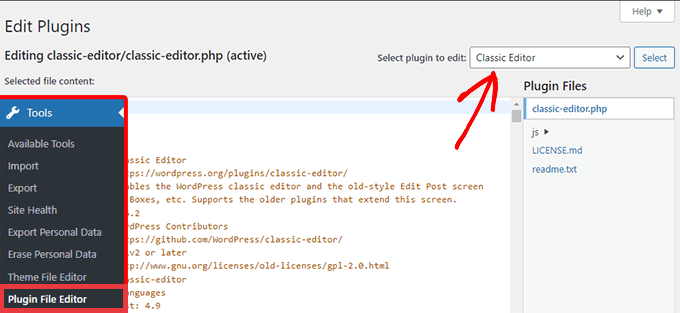
Une fois que vous avez terminé, cliquez sur le bouton “Mettre à jour le fichier” pour enregistrer vos modifications.
S’il manque quelque chose dans votre code ou si cela risque de casser votre site, l’éditeur/éditrices de l’extension annulera automatiquement vos modifications.
Toutefois, si l’éditeur échoue et que vous voyez l’écran blanc de la mort, vous pouvez utiliser le FTP pour modifier votre fichier d’extension et annuler ces modifications.
La seconde méthode consiste à modifier directement le fichier de l’extension en utilisant le protocole FTP. Allez simplement dans le dossier de l’extension en utilisant votre client FTP. Cliquez avec le bouton droit de la souris sur le fichier d’extension et sélectionnez “Voir/Modifier”.
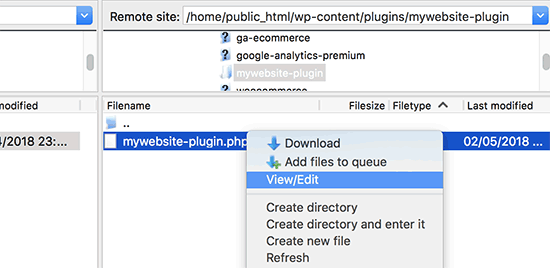
Vous pouvez également télécharger le fichier de l’extension sur votre ordinateur, le modifier, puis le téléverser à nouveau.
Méthode 2 : Ajouter du code personnalisé à l’aide de WPCode (Recommandé)
Cette méthode est beaucoup plus simple et vous permet de mieux gérer vos extraits de code individuels dans WordPress à l’aide de WPCode.
La première chose à faire est d’installer et d’activer l’extension gratuite WPCode sur votre site. Pour plus de détails, consultez notre guide étape par étape sur l’installation d’une extension WordPress.
Publication liée: En savoir plus, consultez notre évaluation complète de WPCode.
Une fois activé, le plugin ajoutera un nouvel élément de menu libellé ” Extraits de code ” dans votre menu d’administration WordPress. En cliquant dessus, vous accéderez à une page où vous pourrez gérer tous vos codes personnalisés.
Pour ajouter votre premier extrait de code, cliquez sur le bouton “Ajouter une nouvelle”.
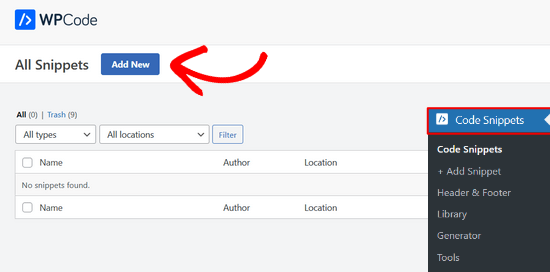
Vous accédez alors à la page “Ajouter un extrait”. Vous pouvez choisir un extrait de code dans la bibliothèque prédéfinie ou ajouter votre code personnalisé.
Pour ajouter un code personnalisé, accédez à l’option “Ajouter votre code personnalisé (nouvel extrait)” et cliquez sur le bouton “Utiliser l’extrait”.
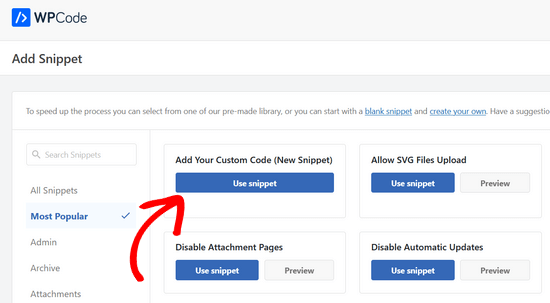
Vous pouvez maintenant saisir un titre pour votre extrait de code personnalisé. Il peut s’agir de n’importe quel élément qui vous aide à identifier le code.
Vous pouvez ensuite coller votre extrait de code dans la boîte de code. Vous devez également sélectionner le type “Extrait de code PHP” dans la liste déroulante “Type de code” à droite.
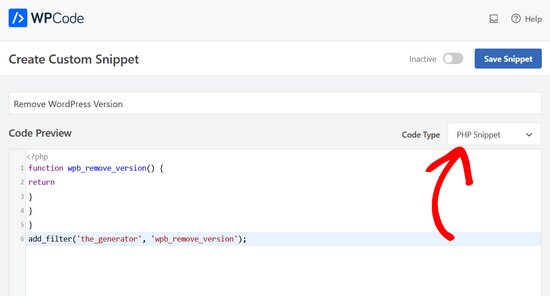
Vous pouvez également ajouter des notes pour le code dans la section “Informations de base”.
Vous devriez utiliser cette zone pour écrire ce que fait ce code, où vous l’avez trouvé et pourquoi vous l’ajoutez à votre site. Cela aidera le “futur vous” à se souvenir de la raison pour laquelle le “passé vous” a ajouté ce code.
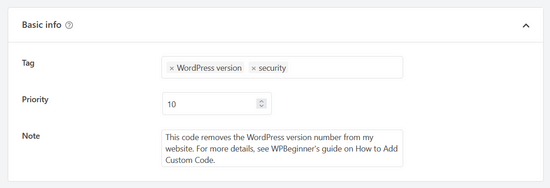
Vous avez également l’option d’assigner des identifiants à vos extraits de code, ce qui peut aider à organiser les extraits de code par sujet et par fonctionnalité.
L’extension vous permet également de sélectionner le mode d’exécution de l’extrait de code. Dans la section ” Insertion “, vous pouvez sélectionner la méthode ” Insertion automatique ” pour insérer et exécuter automatiquement le code sur votre site.
Vous pouvez choisir parmi les options suivantes : zone d’administration, interface publique ou partout. Si vous n’êtes pas sûr, conservez l’option par défaut “Exécuter partout”.

Vous pouvez également choisir la méthode du “code court”. Avec cette méthode, l’extrait n’est pas inséré automatiquement. Une fois l’extrait enregistré, vous obtiendrez un code court que vous pourrez insérer manuellement n’importe où sur votre site.
Vous pouvez également utiliser la section “Logique conditionnelle intelligente” pour afficher ou masquer les extraits insérés automatiquement en fonction d’un ensemble de règles.
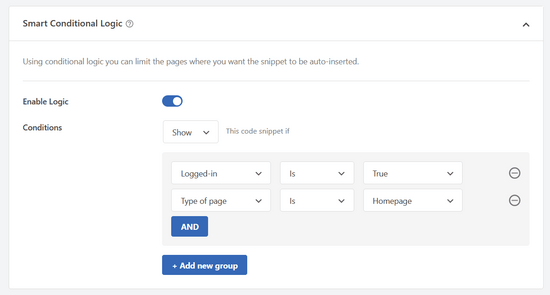
Par exemple, vous pouvez charger des extraits de code uniquement pour les utilisateurs/utilisatrices connectés, charger des extraits de code PHP uniquement sur des URL de pages spécifiques, afficher des extraits de code en fonction du type de page, etc.
Enfin, vous pouvez permuter le commutateur de “Inactif” à “Actif”, puis cliquer sur le bouton “Enregistrer l’extrait”.

Si vous souhaitez enregistrer l’extrait de code sans l’activer, cliquez uniquement sur le bouton “Enregistrer l’extrait”.
Une fois que vous avez enregistré et activé un extrait de code, celui-ci devient automatiquement effectif sur votre site si c’est la méthode d’insertion que vous avez choisie.
Pour plus de détails, consultez notre guide sur la façon d’ajouter facilement des extraits de code personnalisés dans WordPress.
Nous espérons que cet article vous a aidé à apprendre pourquoi et comment créer une extension WordPress spécifique à un site. Vous pouvez également consulter notre liste d’astuces utiles sur les fichiers de fonctions et les hacks WordPress les plus recherchés pour utiliser au mieux votre extension spécifique à un site.
Si vous avez aimé cet article, veuillez alors vous abonner à notre chaîne YouTube pour obtenir des tutoriels vidéo sur WordPress. Vous pouvez également nous trouver sur Twitter et Facebook.





Stephanie
I’m getting the same error as Sonya above. Does anyone have a fix?
Parse error: syntax error, unexpected T_LNUMBER in /home/statisu0/public_html/wp-content/plugins/statisticshowto-plugin/statisticshowto.com-plugin.php on line 10
WPBeginner Support
your plugin file name contains .com in it. It should be statisticshowto.php instead.
Admin
Susan
Hi again. I’ve been reading through all of the comments above and, while some show your answer and resolution to the problem, many don’t. So it’s hard for me to learn from how others resolved their problems! Anyway, here’s what I’m wondering: if by following the instructions in this post to create a folder within my “plugins” folder, how will I be able to see my new site-specific plugin file?
For example, I followed the instructions to create a folder called susansinthegarden-plugin. Then I put my plugin code in a file called susansinthegarden-plugin.php. I can’t see the plugin when I go to plugins on my dashboard.
Is this because the new plugin text file exists in a sub-folder under “plugins”? I can’t figure out what I’m missing but really need to resolve this. Is there anyone out there who can help me? Thanks so much!
WPBeginner Support
No. Please make sure that your plugin’s header area is properly formatted.
Admin
emy
Hi,
What is a plugin header and how do I format it?
WPBeginner Support
Hey Emy,
The plugin header is the part that tells WordPress that this file should be treated as a plugin. It also tells WordPress the name of the plugin, version, and other information.
In the code shown above, the header part begins right after the first line and ends at line 5. It contains plugin’s title and description.
Susan
OK, I resolved my program. Not being a code-writer, I didn’t realize that there was a separate header to wrap around the code I was borrowing. Duh. Thanks for your help.
Susan
I followed your instructions to create a folder under wp-content/plugins etc. and put the file containing the code into that folder but I can’t see my new plugin when I go to my dashboard and look under plugins. Did I miss a step? Thanks in advance for your help!
Edgar Ramirez
Hello
I created the directory and the php file but i cannot see the plugin at all
/wp-content/plugins/yoursitename-plugin/
Open a blank file and save it as “yoursitename-plugin.php”
dont see it on the dashboard plugin list and neither in the Plugin>editor
Can you please help me
Sonia Lacasse
Never mind! Looks like I found the problem. Thanks for your awesome work!
Sonia Lacasse
When I try to activate the plugin, I get the following error message:
Plugin could not be activated because it triggered a fatal error.
Parse error: syntax error, unexpected ’06’ (T_LNUMBER) in /var/www/domain/wp-content/plugins/ETK-PLUGIN/ETK-PLUGIN.php on line 10
Can you please help?
Thanks!
Catherine Argyros
hi there, when i put this in the directory
I received this error message
The plugin generated 2 characters of unexpected output during activation. If you notice “headers already sent” messages, problems with syndication feeds or other issues, try deactivating or removing this plugin.
but my plug in is activated….. please help me understand what is going on?
thank you
WPBeginner Support
Most probable cause for this error could be an empty space after the last ?> closing tag.
Admin
error message
wonderful, thats exactly what the problem was. Thank you for helping me create my first plugin!
WPBeginner Support
Glad to help
xin a day
“All you have to do is create a new folder in the plugins directory. Example: /wp-content/plugins/yoursitename-plugin/
Open a blank file and save it as “yoursitename-plugin.php”
Put the following code in the file:”
i hv few question on these .
1. i can’t create a folder onthe plugin directory.
2. where to open a blank file ?
3. the plugin diretory cant install that file.
thank you
Sacha
Awesome idea! I’ve always found functions.php a pain, so this method works great!
Alan Shapiro
This is a really useful post–thank you! Perhaps someone else asked this and I just missed it in all the comments, but: will a site-specific plugin override a function that is in the theme’s functions.php? For instance, if there is a “remove_action” in the functions.php, will the same “add_action” in the plugin take precedence?
WPBeginner Support
Both functions.php file and site-specific plugin are treated as plugins. Functions.php file loads after plugins but they do not have precedence over eachother. This is why using the same function in both files can cause unexpected results. The best way to override pluggable code is by using hooks and filters.
Admin
Robert Masters
I’m building a plugin at the moment for a multisite network and I need certain functionality available only in specific sites, so this is a perfect article for me right now.
I have one question though…..how do I name the site plugin folder for a site that is created as a subdomain? Example: subdomain.mainsite.com would it be subdomain-mainsite-plugin or just subdomain-plugin?
Hope this makes sense, question based on your tutorial.
hans
very good. when you create a second instance don’t forget do give the “register and load” function an own name, like i did
Eric Ellis
That’s great. I always figured it was pretty simple. Thank you for the information.
Jide
Nice one there. Kindly update the post to inform readers that after activating the plugin, they will have to click on the “edit” link on the plugins page, to add their codes.
Most newbies might not know this…
WPBeginner Support
Actually we do not recommend editing plugins and themes from WordPress admin area. Instead, we would recommend editing your plugins in a text editor via FTP client. This way in case of an error you would be able to quickly fix it without losing access to admin area for too long.
Admin
Mark Holland
Thank you thank you thank you!! This has solved an issue that’s been puzzling me for weeks – and now solved in less than 1 minute.
Can’t express how grateful I am for you sharing your knowledge – thanks again!
Luca
Thank you for the advice! But now I’m confused: what’s the difference between this method and the plugin “Code Snippet”? Is the result the same? Or do they accomplish the same thing in a different way?
Malcolm
Three years later this post is still giving – It’s changed the way I think about customising wordpress – Thank you!
I tried this today and created a a site-specific-plugin with code to hide the wordpress menu bar for non-admins, and to add my latest post to a ‘Current issue’ menu item. Both worked perfectly.
But the third snippet I added to the plugin failed to work. When I copied the code to the child theme’s functions.php it worked as expected.
Can you explain why this would happen?
I’m trying to modify the effect of the plugin “Restricted Site Access” by allowing access to more than a single page. The code I tried in my site specific plugin and the functions.php was:
//
add_filter( ‘restricted_site_access_is_restricted’, ‘my_restricted_check’ );
function my_restricted_check( $is_restricted ) {
global $wp;
if (
$wp->query_vars[‘pagename’] == ‘contact’ ||
$wp->query_vars[‘pagename’] == ‘subscribe’ ||
$wp->query_vars[‘name’] == ‘aplr-2013-volume-21-number-2’
)
$is_restricted = false;
return $is_restricted;
}
Any advice or comment would be welcome. I’m confused!
harklord
after trying this. My site is opening blank… Please help.. Av tried deleting the files i created but still blank
WPBeginner Staff
Make sure that your stored the plugin’s php file in /wp-content/plugins/ folder and not in your theme directory.
Mohammed Amine
Fixed, actually it is necessary to add that php comment in the php file, or else it wont appear on the admin panel.
That php comment is used to show the discription of the plugin in the admin panel.
Paolo Bergomi
Hello,
This is Paolo, i am building my website and theme with WP last edition 4.1.1.
i Am trying to learn custom type fields and I found your website very useful. i hav ea issue, though: even if following this post i created the folder my theme plugin and with the related file .php you mentioned here, for the site specific plugin, copy all in localhost using WAMP server. i opened then my dashboard, went to plugins but my new plugin dont appear. what is going on? did i miss anything? thanks
paolo
WPBeginner Staff
You can try and fit your modifications in site-specific plugin by using filters. However, since you had to edit specific files we doubt that all your edits can be implemented in a site-specific plugin using filters. In that case you should make those changes into a child theme. All your custom CSS should also go into your child theme’s stylesheet. You can also use your site-specific plugin to enqueue a custom stylesheet.
Bas van der Linden
Hmm, looks like my last post went missing while registering for this annoying disqus plugin.
Anyways:
At first I’d like to thank you for sharing this information.
Secondly I do have several questions regarding this post.
1) Is it possible to also make site specific plugins for other .php’s where I’ve added some codes?
Such as front-page.php post-page.php and post-archives.php
2) Is it possible to do something like this for .css codes?
I run genesis as framework(Parent theme) and a child-theme that I’ve downloaded.
Now since there are no grand-child theme’s in wordpress I’ve made my alterations in the child-theme’s folder
This includes a lot of different .css edits, Is there a way to make site specific .css files/plugins like this, so I can maintain the origional child-theme (and perform an update if any updates are released)?
3) When I create a site-specific plugin to change the footer and activate it, I will see both the origional footer and my own footer on the site.
Is there a way to go around this?
My plugin looks like this:
Once again thank you for sharing this information on site-specific plugins, and I hope to hear soon from you guys.
Chelsey
Thank you for your patience… I’m still trying to figure out how to ‘create a new folder to plugins directory’
Rodney Lacambra
Hi Chelsey. Consider this guide:
Go to “File Manager”. It will take you to “/public_html” directory. Click on “wp-content >> plugins” . This is where you will “create” a folder called “yoursitename-plugin”. After that, create a file using some text editor(notepad++), paste the code given above and save the file as “yoursitename-plugin.php”. Upload it to “yoursitename-plugin” folder and activate it in your wordpress admin area. Easy as that!
Hope it helps you a lot.
Regards,
NomadTech
Benjamin Mukasa
This is a great post. I followed the instructions but the plugin is not appearing in my plugin list.
Paolo Bergomi
me same..where did we make wrong? thanks in advance for any tips to solve this
WPBeginner Staff
yes you can use it for multiple functions.
WPBeginner Staff
Your code seems to be correct. Here is what you can do:
Make sure you have saved the plugin file in the /wp-content/plugins/ directory.
Make sure that your plugin file name is correct. We recommend using yoursitename.php format. For example if your domain name is black-circles then your plugin file name should be black-circles.php
SteveMTNO
I originally had the plugin file (bc-plugin.php) in its own directory called blackcircles/wp-content/plugins/bc-plugins. That didn’t work.
Then I tried moving the bc-plugin.php file from that folder to the blackcircles/wp-content/plugins folder. Still doesn’t show up in my admin panel.
Do I have to “enable” it first before it shows up or something?
Confused….
WPBeginner Staff
If the file is correctly placed in your plugins folder then you will see it in your WordPress admin area under Plugins. If you see your plugin there, then you will have to click on the activate link below the file to activate the plugin.
Did you try renaming the file to something else?
SteveMTNO
Tried renaming it 3 times – none of them show up….
I must be doing something wrong (or not doing something that I should be doing)…
SteveMTNO
So can I use this one site-specific plugin for multiple functions, or is it best to do something similar to this for each one?
Michael Cuomo
I’m having a similar issue with mine. I’ve created a site specific plugin to create a custom content type, but the custom content type is not showing up in my admin panel underneath pages like it should.
SteveMTNO
I posted this yesterday, but it seems to have vanished…
Anyway, I followed the instructions above, but can’t see the site-specific plugin in my admin panel.
Here’s a link to my code:
http://pastebin.com/fbeGr8gh
SteveMTNO
I followed all of the instructions above, but my plugin doesn’t appear in my admin panel.
Here’s my pastebin link:
http://pastebin.com/fbeGr8gh
Thanks!
SteveMTNO
WPBeginner Staff
There were spaces in your PHP opening and close tags
is the closing tag there is no space between them. See the corrected version here and compare it with your code. Hope this helps
http://pastebin.com/JJ7WfpUR
UgochukwuEmmanuelAgbams
i got this message while trying to install it.
The package could not be installed. No valid plugins were found.
WPBeginner Staff
This usually happens when your plugin’s header is not valid. Please paste your code in pastebin.org and paste the link in a comment.
UgochukwuEmmanuelAgbams
thank you for your response. here is the link of the code on pastebin http://pastebin.com/vksUVmCa
Rajesh Ghadge
Very useful aticle it can help any novice in the designing field thanks a million
Joe Librizzi
This is a fantastic post, thanks! Quick question – could this same method be used to modify an existing plugin, sort of like you can use a child theme to modify existing CSS? I know you can modify a plugin directly, but I’m trying to avoid losing the modifications when the plugin is updated.
WPBeginner Support
Joe, yes this can be used to modify plugins. Another way to modify plugins safely is by changing their header information. You can use the header shown in the above code as an starting point.
Admin
Correen
Successful! Thanks for showing me how to get this accomplished.
Chris
I am new at this and learning as I go but I am confused as in the instructions both the singular and plural version of plugin was used. Am I to create one plugin file to put all snippets into or seperate plugins for each code/snippet/task?
For example – I found this article by gooling for how to create more than one custom post type. Would I put each custom post type into a seperate plugin?
Or could the code for custom post type go into the same plugin file as theme support for post thumbnails as I have it currently in my functions.php?
WPBeginner Support
The code for all your custom post types can go in one plugin.
Admin
Shemul
what about custom.css? can we made something like this. it is good to have child theme then.
WPBeginner Support
A child theme is always recommended but there is a fine line as to how much functionality themes should have and what functionality should fall under plugin domain.
Admin
Sussie T
Great article. I did this, and it was very easy. But now I am taking this further and made another file to my plugin for the site specific widgets. My first widget.
Have fully created 2 widgets, but only the last one is showing in admin. I guess is something with hooks or register_widget, but i cant crack this one.
Seams like an easy error to solve, if you got the experience. But for a beginner Google is not helping at all.
Resume of my widget file:
widget script
widget script
a function witch registers my 2 widgets
Outside this function is add_action(widgets_init, name of above function)
Please help
paul
so when i read
Paste this code in your theme’s functions.php file or your site-specific plugin
i just create this site-specific plugin and add code to this rather than my functions.php
Duy Dang
Thank you so much, it’s very useful!
Junior Godoi
And what about mu-plugins folder?
Max
Your site is god sent! I’ve literally been going through each of your tutorials, making a list of all the one’s I’m going to be implementing on my new site I’m developing. Some things you have covered, I would of never even have thought about, but now I am definitely dong them. Thanks for all the information you provide with your blog.
Editorial Staff
Thanks a lot for the kind words Max. Let us know if you have any questions or suggestions by using our contact form.
Admin
Hamza Aid
I’m managing a heavy loaded WP portal, and I found many problem when performing modifications because the developer made the same mistake, and put all the code (functions, etc..) in functions.php
Now, I re-designed the portal, and separated many functions to site specific plugins. Thanks for this great post
Mattia Frigeri
It must be said.
This is a superlative post.
Greg
I am not sure what it is I am doing wrong. I have done exactly as you have said and I can not get it to show in my WordPress Plugins.
I have FTP’s it in, zipped it and tried to upload it via the admin and activating it (wp actually recognized it, and when I clicked the “Activate” link …. nada. It is like it was never there and when I FTP’d back in, it wasn’t there either.
So I am trying Brent Logan’s plugin he mentioned (Code Snippets).
Hopefully I’ll have better luck.
I appreciate the article though. Thanks.
(I am not that new to this. I have played with WordPress and Drupal and their plugins quite a bit. I am not sure why it is that I am having so much trouble with it.)
comment would be appreciated — and I will keep reading here as well.
Editorial Staff
That is actually very weird. Even when you FTP this, the file goes away from the folder?
Admin
Billy Patton
…I tried to keep this method a secret. hahaha
Brent Logan
I was doing this until I found the Code Snippets plugin. This plugin makes it easy to add multiple snippets, with a place for easy descriptions, and then activate or deactivate the snippets individually. Quite slick.
b.nijhoff
I always thought it was really hard but after seeing this I now know I could do it to. Thanks for sharing this, all your articles have been really helpful so far. Keep on the good work!
ericsavina
What I don’t get is that I keep reading everywhere that I should modify the functions.php instead of adding plugins. It is supposed to make the site faster. So, who should I trust? The idea of having a separate file for a the changes I’m making to the funtions.php file seems very interesting. At least, I would be able to easily update my theme without having to check every time the customs changes I made.
CreativeBoulder
@ericsavina From what I have been gathering, and I’ve been doing this for a good while, is that the speed and performance using a ton of PHP in your functions.php versus additional plugins that use the same code– I was not able to find much of a difference in speed. Now, anybody correct me if I am wrong and if anybody has different performance comparisons.
At this point, I’m using my functions.php file as I outlined to keep my functions organized along with a few custom plugins that I have designed with multi-site purpose. Hope that all makes sense.
ericsavina
@CreativeBoulder Thanks for your answer. I will create this plugin and check if there are any differences in loading time.
CreativeBoulder
@ericsavina Not a problem. Please let me know if you find out some different results than I did? Google Chromes Web Developer Tools have been more than helpful in performance and load-time and same with http://loads.in/.
CreativeBoulder
I fully understand the reasoning behind this setup. I really like the concept. When WordPress Upgrades, then you might need to upgrade some of your functions instead of having to navigate a possibly unorganized file structure. I was thinking about this about a week ago when working on a client site and did this with my functions.php:
<?php
// Require Administrator Functions/Classes
require_once(“lib/php-classes/wp-admin-functions.php”);
// require Custom WP Plugins (By BusinessName)
require_once(“lib/php-classes/wp-general-functionality.php”);
require_once(“lib/php-classes/wp-register-sidebars.php”);
require_once(“lib/php-classes/wp-register-menus.php”);
require_once(“lib/php-classes/wp-register-customposts.php”);
require_once(“lib/php-classes/wp-load-jslibs.php”);
require_once(“lib/php-classes/wp-breadcrumbs.php”);
require_once(“lib/php-classes/wp-shortcodes.php”);
?>
Which allowed me to basically work on certain aspects and know where certain custom widgets or shortcodes were instead of a huge functions.php file. What do you think? Which method works better for you?
affanruslan
@CreativeBoulder No, this function.php file is within your theme file, not the core wordpress file
CreativeBoulder
@affanruslan I fully understand what the concept here is. Thanks for the reply. The goal of creating a Site Specific Plugin is to keep your functions, widgets, short-codes (etc) separate so that they are easier to work with and more organized. My concept of using your Theme Specific functions.php and “modularizing” it into separate files is just as easy to stay organized. That’s what I was getting at. I appreciated this post. =)
tomdana
At first I was confused on what this Post was about. Once I read it I realized the usefulness of doing exactly what you suggest. I named my plugin “site-specific-functions”. Thanks for the information and all you do.
tomdana
At first I was confused on what this Post was about. Once I read it I realized the usefulness of doing exactly what you suggest. I named my plugin “site-specific-functions”. Thanks for the information and all you do.
fergusonsarah
It’s really great to read such a valuable blog post here, thanks for sharing.